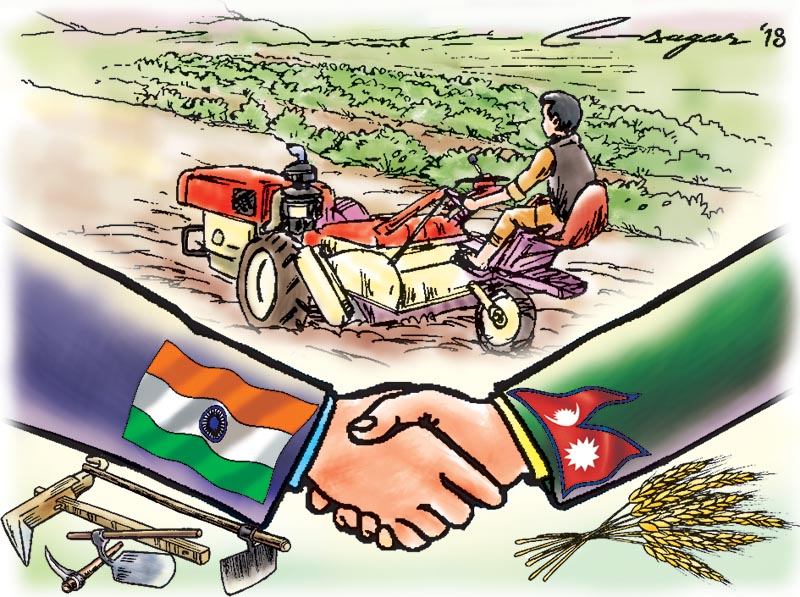Agriculture partnership: The scope and benefits
The private sector in India is strong in seed industry and it can help build the capacity of Nepali seed enterprises. The role of Nepal government should be facilitative, enabling the private sector to take the lead role in the development of agriculture
Nepal and India have agreed to give a fresh momentum to bilateral cooperation in the agricultural sector. Cooperation in the agriculture sector was the major focus during Prime Minister KP Oli’s visit to India last month and Indian Prime Minister Narendra Modi’s visit to Nepal on May 11-12.
Nepal and India share similarities in many aspects, including agriculture. Agriculture of both countries is cereal based. Rice, wheat and maize are the main crops followed by vegetables and fruits.
The GP Pant University of Agriculture and Technology (GBPUAT), which has made valuable contributions in modernisation of the agriculture sector, is situated near Nepal. The area where it works has geographical conditions similar to Nepal. The seed production centre and integrated farming model established in the university are noteworthy. One of the thematic areas of partnership can, thus, be the development of seed industry. High quality seeds play the most important role in increasing crop production. To ensure the use of good quality seeds, they should be made available at the right time and right place at reasonable prices.
Nepal lags far behind when it comes to utilising available resources in developing appropriate varieties of seeds, their production and increasing investment for seed infrastructure. The seed production technology developed by the GBPUAT can be implemented in the western part of Nepal due to similarities in production conditions. Similarly, other modern technologies of agriculture used in Himanchal Pradesh, Uttarakhanda, Uttar Pradesh, Bihar and West Bengal can also be implemented in Nepal.
The only question is: How to get an easy access to these technologies?
One of the ways could be implementation of the MoU to be developed by the two governments for the cooperation the agriculture sector. Furthermore, entrepreneurs and farmers from the two countries can be brought together to exchange their experiences and planting materials they have.
The Indian private sector in seed industry is strong and it can help build the capacity of Nepali seed enterprises through internships, short-term trainings and collaborative researches.
ICT in the agriculture sector is of special significance and plays a vital role in the transformation of services as well as agricultural products. Various high-tech information and communication technologies are in use in the agriculture sector around the world and India. These technologies range from the agricultural product development, marketing and distribution to training agriculture sector personnel. Nepal and India can initiate networking of stakeholders through ICT and establishment of specialised agricultural knowledge system. Such system can empower farmers and technicians of both countries providing market information and forecasts.
Another thematic area of partnership could be agricultural mechanisation, which has direct effect on land and labour productivity. Indian experience with agricultural mechanisation has been marked with major successes over the past few decades. Exchanging these experiences of how mechanisation has evolved in India can help identify alternative approaches and design effective mechanisation policies in Nepal.
The role of government in the development of mechanisation should be facilitative and regulatory, enabling the private sector to take the lead role in the provision of agricultural mechanisation services. Current policies could be adjusted in order to engage and encourage the private sector to take lead roles in the machinery supply chain.
We all know that the agricultural sector is highly vulnerable to climate change. Recent climate-related events in Nepal, such as drought, unusual pattern of rainfall, rising temperatures, winter cold wave in the Tarai, have negative impacts on food security in Nepal. Similar impacts can be observed in the northern parts of India. Therefore, joint efforts to reduce such climate change impacts should be made, incorporating a strong capacity building component at government and community levels through awareness raising campaigns as well as analytical tools to ensure that risks and vulnerabilities are identified and mapped. Nepal’s poverty can only be eliminated by utilisation of water resources through irrigation. Water is regarded as the key strategic natural resources having the potential to be the catalyst for the development of agriculture.
One of the main issues related to irrigation is high capital cost for physical infrastructure development.
In order to be grain self-sufficient, substantial increases in agricultural production will be needed which is possible only if we have a reliable irrigation system. Similarly, agricultural productivity and food security suffer from inadequate investment in irrigation and flood management in the northern parts of India. Recently, India has agreed to provide direct access to Nepal to the sea through development of water resources.
As Nepal and India depend on each other for water and water-related services, bilateral water utilisation projects with win-win solutions should be designed and implemented. Establishment of an inter-country irrigation grid could facilitate the utilisation of water for agriculture development.
Kaini is former director general of Department of Agriculture






